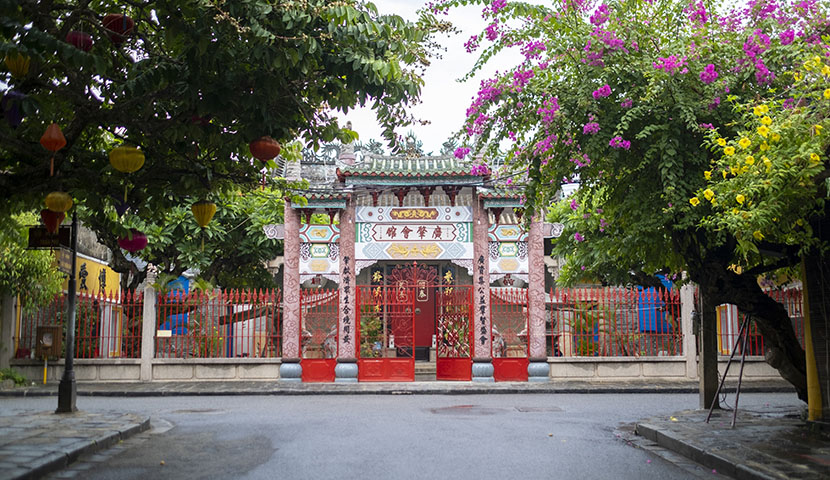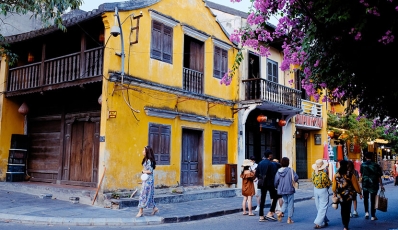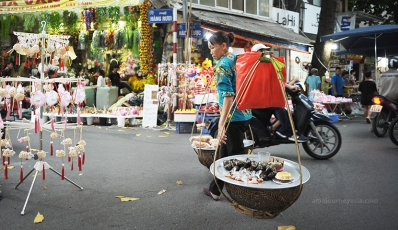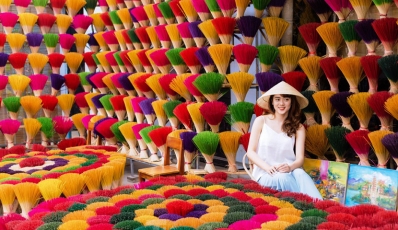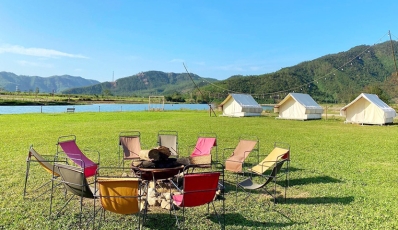Hoi An Old Town is often known as a historic zone with nostalgic and magical beauty. This is an area with a lot of gorgeous sights of saffron-coloured and lovely habitats that are worth discovering and experiencing.
Among the Hoi An tourist attractions, such as Japanese Bridge Hoi An, Tan Ky Ancient House, Thanh Ha Pottery Village, 5 assembly halls of the Chinese community are must-see spots when you visit this beautiful ancient town. Let's explore these 5 halls!
2. Duong Thuong (Chinese) Assembly Hall (64 Tran Phu)
3. Phuc Kien (Fujian) Assembly Hall (46 Tran Phu)
4. Hainan Assembly Hall (10 Tran Phu)
5. Trieu Chau (Chaozhou) Assembly Hall (157 Nguyen Duy Hieu)
*****
What is the assembly hall?
An Assembly Hall serves as a gathering hub where members convene, interact, engage in trade, and offer mutual support in their life endeavors.
These halls are also sacred spaces that pay homage to various deities in accordance with the cultural beliefs of the Chinese group. Additionally, they serve as venues for the community's annual rituals and offerings.
Hoi An's historic town was once a pivotal trading port, drawing merchants from China. During this period, Chinese traders constructed assembly halls to serve as shared spiritual centers for the local community.
1. Quang Trieu (Cantonese) Assembly Hall (176 Tran Phu)
Cantonese Assembly Hall (also known as Quang Trieu Assembly Hall) was built in 1885. Initially, it was to worship Thien Hau Thanh Mau and Confucius, but after 1911, it converted to worship Quan Cong and Tien Hien.
The assembly hall has beautiful architecture because of the harmonious combination of wood and stone materials in the bearing structure, ornate motifs, and delicate carvings. Such details give the building a majestic and splendid appearance.

Dragons in Cantonese Assembly hall
In the middle of the yard, there is also a large lake, embossed with a meandering dragon shape according to the story of "Ly Ngu Hoa Long – Fish turns into a Dragon". This place still houses many ceramic artefacts, images reproducing cultural plays and many documents about the life of the Cantonese community in Hoi An.
2. Duong Thuong (Chinese) Assembly Hall (64 Tran Phu)
Duong Thuong Assembly Hall (also known as Ngu Bang Assembly Hall, Chinese Assembly Hall) was built in 1741 with the contribution of traders from 5 counties: Fujian, Chaozhou, Guangzhou, Hainan, and Hakka. This is the place where Thien Hau Ngu Bang is worshipped and activities of compatriots of Chinese people in Vietnam are organized.
The assembly hall has a bold Chinese architectural style and has undergone many restorations, but basically, it retains the original architectural style. Inside the hall, there are three stone steles, recording the origin, restoration, and renaming and mention of the treasure as a 500-year-old iron crest.

Duong Thuong Assembly Hall in Hoi An
The assembly hall also worships the gods Thien Ly Nhan, and Thuan Phong Nhi - the Chinese geniuses and models of sailboats and boats used by the Chinese as means of maritime trade.
In addition, in the backyard of the hall, there is also a Le Nghia basketball court. It has an ancient school garden setting reminiscent of a school day. In particular, there is a giant wall with Chinese characters - one of the hottest check-in points in Hoi An today. Just stand next to this wall, and you will have a very cool photo as if you were travelling in some ancient cities.
3. Phuc Kien (Fujian) Assembly Hall (46 Tran Phu)
Among the 5 ancient assembly halls, Fujian is the largest and most known to tourists. According to legend, the forerunner of this assembly hall was a small shrine worshipping the statue of Thien Hau Thanh Mau in 1697. Through many restorations, the assembly hall has become more and more brilliant and spacious.
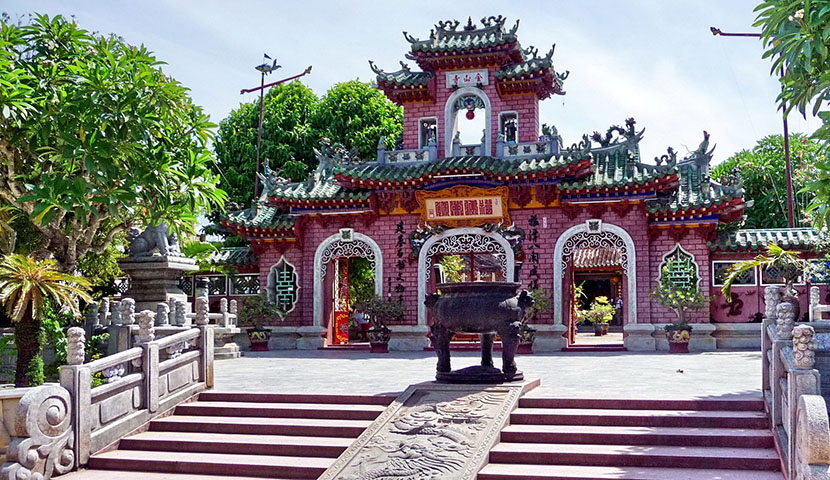
Fujian Assembly Hall
The building has an architecture in the style of the letter Tam meaning Three, in the following order: the three-way gate, the courtyard, two rows of East-West houses, the main hall, the backyard and the back hall.
The Fujian Assembly Hall deeply embodies the Asian philosophy of human happiness. This place was granted the title of a national historical-cultural relic on February 17, 1990, contributing to adorning the appearance of the unique architecture of Hoi An ancient town.
4. Hainan Assembly Hall (10 Tran Phu)
Hainan Assembly Hall (also known as Quynh Phu Assembly Hall) was built by overseas Chinese in Hainan County - China in 1875. This assembly hall worships 108 Chinese merchants who were unjustly killed by Nguyen's military officials.
Mistakenly as a pirate ship, they fired a cannon and sank their boat. After thoroughly investigating the matter, King Tu Duc ordained them as "Nghia Liet Chieu Ung", allowing the construction of a temple to worship them.
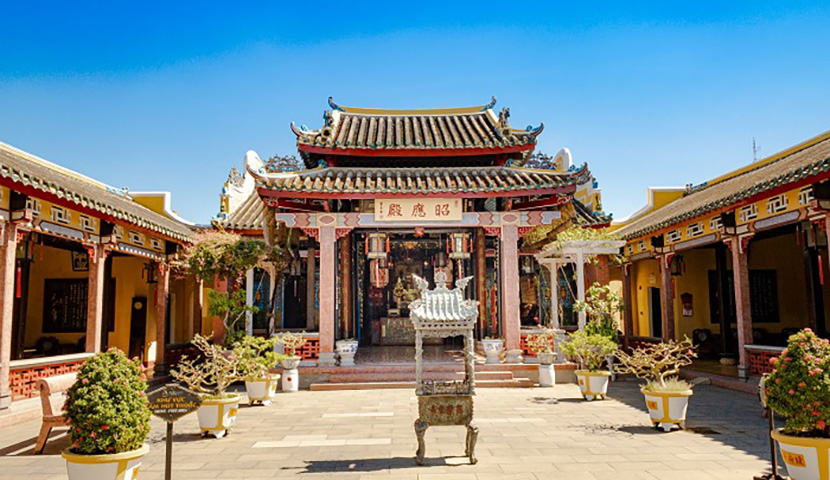
A conner of Hainan Assembly Hall in Hoi An
Hainan Assembly Hall is built in the shape of the character “Quoc” meaning “nation” on a large scale, including the front hall, the main hall and 2 houses, East and West. The main hall was built on a fairly large scale with large columns standing on marble pillars. The altars in the main hall are intricately sculpted, showing the artistic ingenuity of traditional sculptural techniques.
In particular, the altar in the middle is embossed and gilded with very splendid and majestic scenes of the three worlds of "heaven, earth, and sea".
5. Trieu Chau (Chaozhou) Assembly Hall (157 Nguyen Duy Hieu)
This assembly hall is located on Nguyen Duy Hieu Street (from Tran Phu Street towards Cua Dai Beach), with a calm and quiet appearance over time, built in 1845 by the Chinese community of Chaozhou to serve as a place to organise community activities and worship the god Phuc Ba - the god who specialises in controlling the wind and waves, helping to make travel and trade on the sea peaceful and smooth.
This is one of the works of special value in the architectural complex of the ancient city. The wooden frames, the altars, and the door system are carved with sharp woodwork. There are decorative motifs according to legends, and folk legends, elaborate and beautiful crockery embossed works on the banks of the roofs.

Chaozhou Assembly Hall in Hoi An
Every year, on the 16th day of the first lunar month, the Chaozhou Assembly Hall organises a very solemn ceremony to worship the Nguyen Tieu (first full moon) Festival and the death anniversary of their ancestors, with the participation of a large number of Chinese people of Chaozhou origin in Hoi An and neighbouring localities such as Hue, Da Nang, and Quang Ngai.
In the above-mentioned 5 architectural works, there are 2 assembly halls that visitors can visit for free: Duong Thuong Assembly Hall and Hai Nam Assembly Hall. For the remaining assembly halls, the ticket price for Vietnamese people is at 80,000 VND and that for foreigners is at 150,000 VND for 3 places (out of 21 fee-based attractions in Hoi An ancient town).
Related articles
